The Definitive Guide to What’s Happening at SDSU Imperial Valley
Sixty-five years ago, SDSU took over an elementary school in Calexico, California, and turned it into a destination for upper-division students. Today, it offers four-year degrees and is expanding its footprint in STEM, providing an essential workforce pipeline for the area.
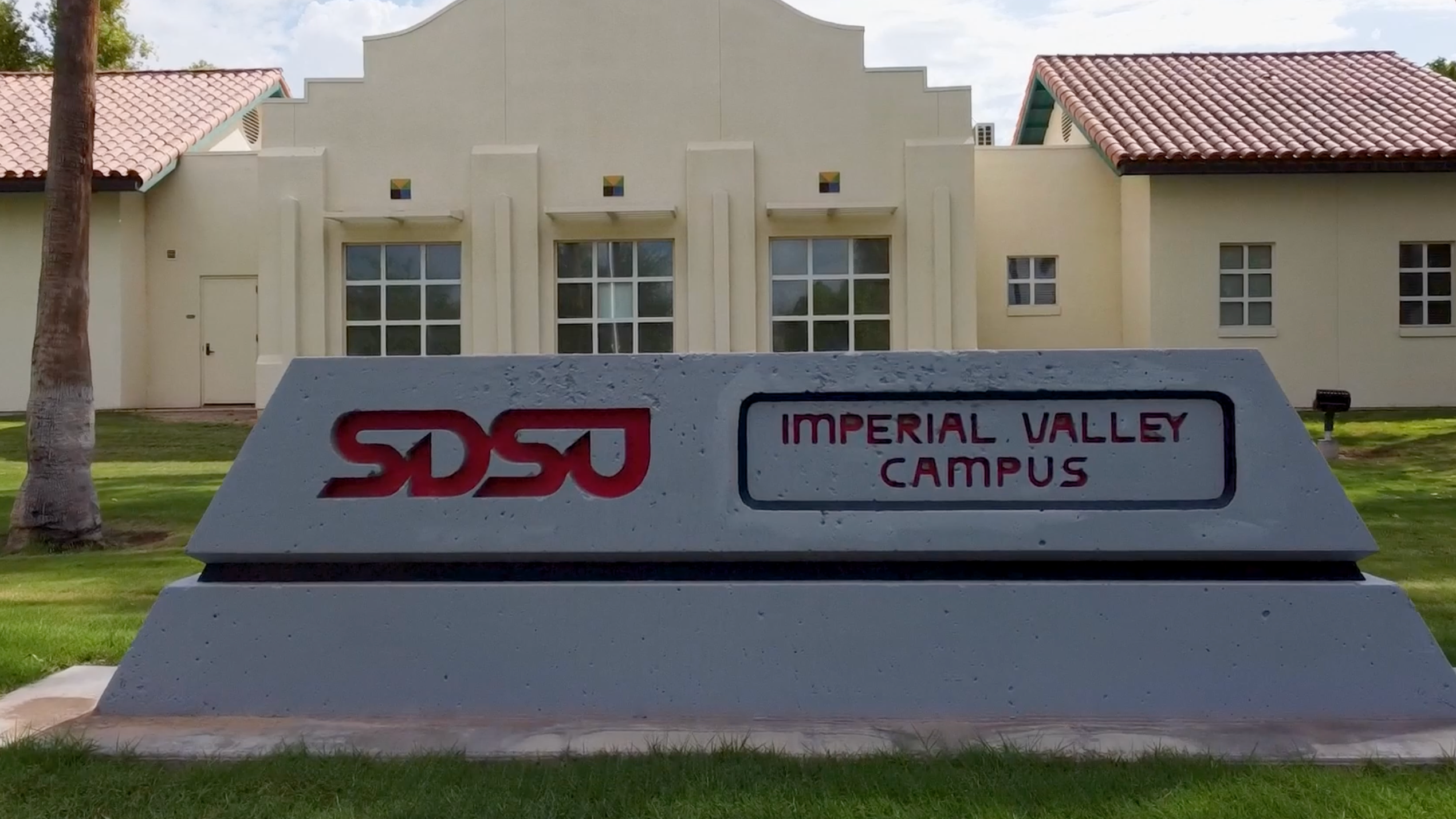
A PROMINENT MURAL on the outside of a classroom building in Calexico, California, located near the U.S.-Mexico border, depicts what might be considered a classic Imperial Valley story. In familiar Chicano strokes, three students are using books as stepping stones to reach the halls of the university. To the left, family members cheer from an agricultural field. To the right, a black-robed graduate literally jumps for joy, diploma in hand.
For many graduates of SDSU Imperial Valley, the next part would depict them staying in the area to live and work. A familiar refrain holds that the remote, predominantly agricultural and often stiflingly hot valley inevitably must, as SDSU Dean Guillermina Núñez-Mchiri puts it, “grow our own talent.” With a variety of widely welcomed initiatives, SDSU continues to help do just that, even moreso.
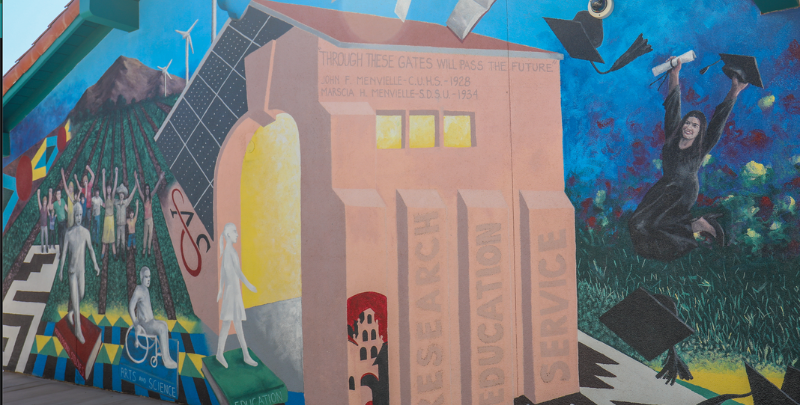
Founded in 1959, the campus for decades functioned as an extension of SDSU, occupying a city block–size campus in a residential neighborhood of Calexico, just about 6 miles from Mexicali, the capital of Baja California. Its once-limited curriculum was strictly upper division, serving transfer students from the local community college. In 2004, it expanded to a site 23 miles away, on a donated parcel just outside Brawley city limits, with the development of a single structure surrounded by farmland that became home to the nursing program.
Today the two sites serve nearly 1,000 undergraduate students in 11 degree programs (among them: criminal justice, psychology and public administration) and more than 100 post-baccalaureate and master’s students. The transition to a four-year institution gathered steam under SDSU President Adela de la Torre. Within months of her 2018 arrival at SDSU, she drove a University Senate action to officially change the nomenclature from “Imperial Valley Campus” to “SDSU Imperial Valley” as a sign of coequal status, a proposal that had lain dormant for four years.
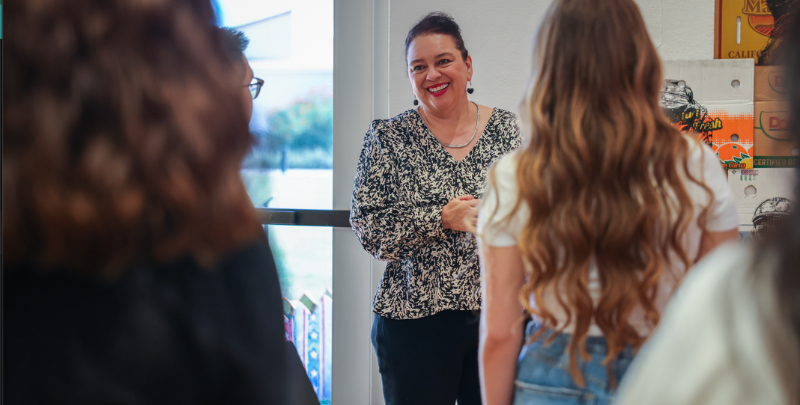
To support this shift, there’s a concerted effort to recruit students fresh out of high school, and planning is underway for the first residence hall. The nursing program, which has just received one of the largest gifts in SDSU Imperial Valley history, now offers an accelerated path to a degree. And perhaps most momentously, the Sciences and Engineering Laboratories, a new STEM facility in Brawley, is set to open in fall 2025 and will house new programs in chemistry and engineering. It will expand opportunities for four-year degrees.
“I think the people of the Imperial Valley have been quite hungry waiting for these new degrees,” says Núñez-Mchiri, a double alumna of the San Diego campus. “People are asking us, What else do you offer? What else can you offer?
“If this campus did not exist, we would not have the opportunity to create educational pipelines for the people of the Imperial Valley.”
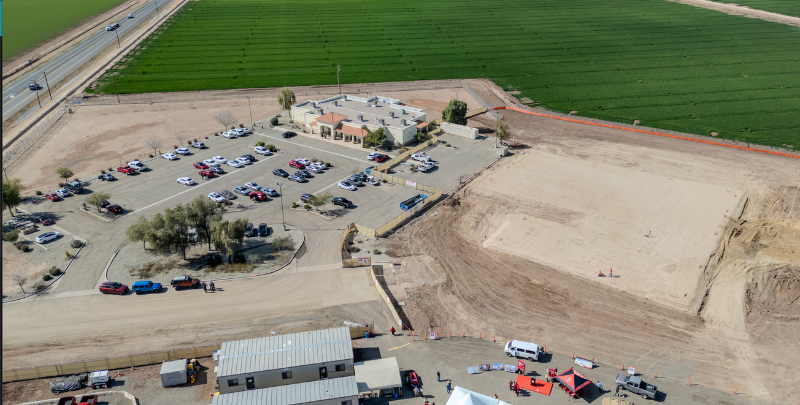
RECENTLY THE LAND northeast of the lone building on the Brawley campus was a lush, green field of alfalfa, used primarily as feed for livestock and one of the primary crops of the Imperial Valley. Now it’s the future site for SDSU Imperial Valley’s role in a carbon-neutral future: the Sciences and Engineering Laboratories is intended in part to tie into the burgeoning lithium extraction industry adjoining the nearby Salton Sea, with whole new courses of study in electrical engineering and chemistry.
Site preparation began in January and is in part funded by $80 million that was allocated by Gov. Gavin Newsom in his role as the state’s chief budget maker.
“We’re going to have new degree programs to train what I call our innovation workforce,” says William Tong, interim provost and a chemistry professor at SDSU, whose nearly 40 years studying lithium began at the Oak Ridge National Laboratory in Tennessee. Today, he works directly with the businesses that make up Lithium Valley, extracting the mineral used for batteries in vehicles like the three 100% electric cars Tong has driven over the past 10 years, considered critical in reducing carbon output and mitigating climate change.
“These companies need students who have had hands-on experience on some of these modern instruments,” Tong says. “By the time they’ve finished their bachelor’s degree, they will have learned everything they need to learn these analyses and separation and find out how efficient the process is.”

Jim Turner, president of Controlled Thermal Resources, is looking forward to the future pipeline of SDSU Imperial Valley graduates. Founded in Australia in 2013, the company has a small-scale plant at the Salton Sea with 42 employees, extracting lithium from the underground brine they pump up, with plans to scale up and supply the product to General Motors, which has pledged to go all-electric by 2035. “We’d love to have a pool of kids that have grown up here,” says Turner.
A lab in the new Brawley building will become a new resource for the Salton Sea operation, Turner says, with students analyzing samples for lithium chloride and any contaminants ― “our eyes and ears as to how well we’re doing.” That job currently requires shipping off samples, but in the future “somebody would probably drop it off on their way home at night.”
Yet another benefit will come to the company’s existing workforce of scientists, engineers and mechanics, Turner says, noting that many are interested in taking additional courses in their field.
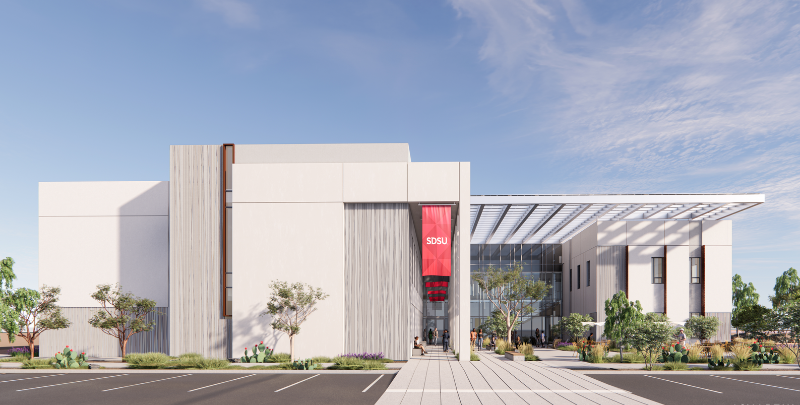
THE NEW SCIENCES AND ENGINEERING LABORATORIES will become the first two-story building either at the Brawley campus or the much larger Calexico campus, and when students first walk in, they’ll see a lobby staircase to the second floor with space to take study breaks or work together, immersed in natural light through windows that look out onto a shaded courtyard.
Susan O’Connell, managing principal with AC Martin, the Los Angeles–based architectural design firm selected for the project, says the staircase was among the ideas to emerge from a critical first step in considering what it would take to ensure student success in the building: “We thought whom better to ask than the students?” she says.
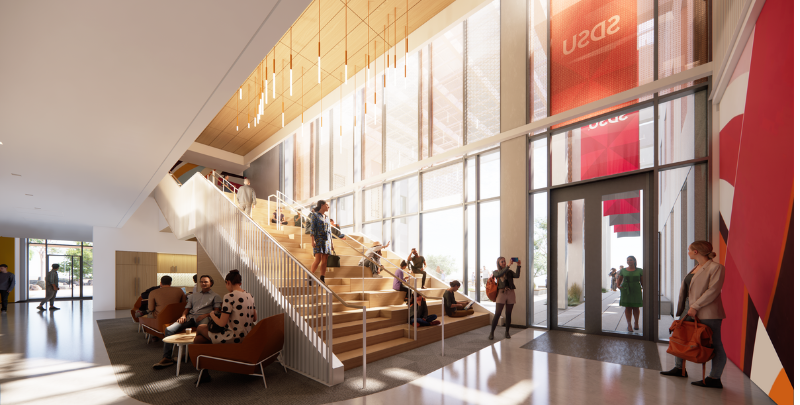
In an event held at the Calexico campus, the AC Martin team asked students questions about their needs, how the interior should look and feel and what makes them comfortable. “We’ve learned that some buildings are incredibly intimidating to students and others are welcoming. And we definitely wanted all of the students to feel welcome," O’Connell says. What they found was students wanted a place to touch down between classes. Students also liked higher ceilings, plenty of glass and light colors, which makes sense when it's hot outdoors.
AC Martin has a history with SDSU in San Diego, having designed two of its most recent new buildings: the Engineering and Interdisciplinary Sciences Complex and Huāxyacac, a residence hall for first-year students. The Brawley building dispenses with the Mission Revival– and Spanish Colonial–style design of the San Diego campus. The concrete walls will have textures drawn from desert plants, including ocotillos, O’Connell says, and the walls will be suitable for murals by local artists.
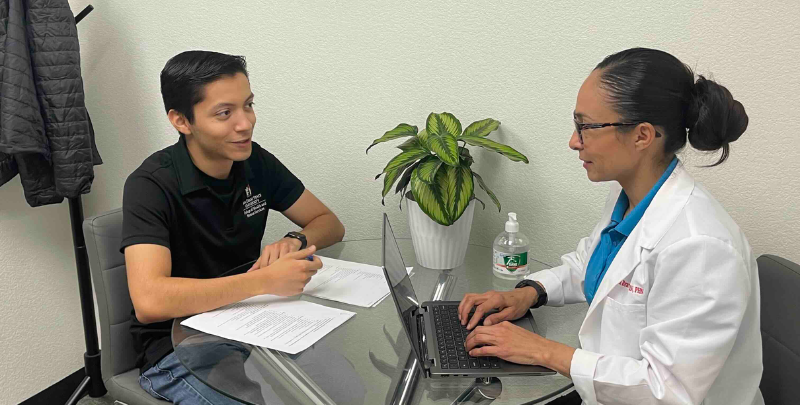
Sebastian Martinez, a Calexico resident and transfer from Imperial Valley College, became interested in nursing as a hospital patient himself at age 15. “That’s where I got to observe the role of a nurse and various other health-care professions,” he says. Now he’s president of the campus Student Nurses Association, aiming for a career in an emergency department, having completed an internship at El Centro Regional Medical Center.
Martinez is one of 10 students in the first cohort of SDSU Imperial Valley’s new accelerated pre-licensure bachelor of science in the nursing program. Introduced in 2022 to address chronic shortfalls in the nursing workforce and their ripple effects on health disparities in the area, the program cuts a year off the previous timeline to complete the BSN by adding summer classes. These 10 will complete their degrees in August but will walk early, participating in commencement ceremonies in May before they take a final class in critical care.
While more intense, the accelerated schedule suits Martinez just fine. “We’re going to be able to obtain our licenses a little bit sooner and provide nursing care to the community,” he says.
Lecturer Carmen Bravo, who teaches a pediatric care course in the nursing program, confirms the accelerated approach is working. She has been trying to keep the class challenging, but “they know their stuff,” she says. “They have retained all of the information.”
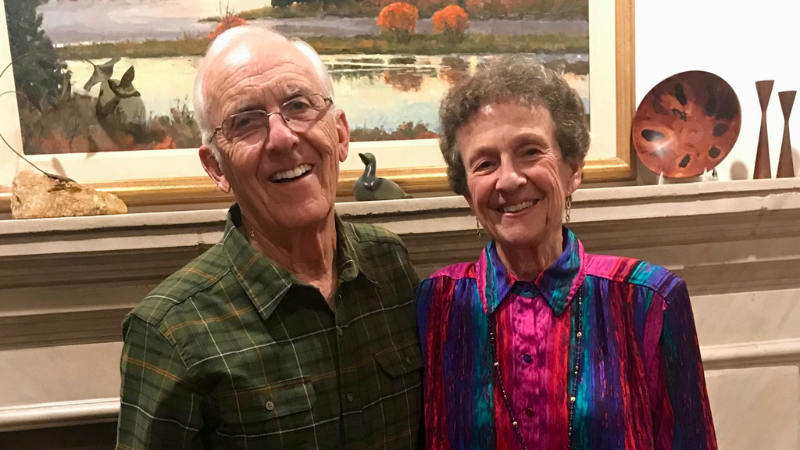
The accelerated program helps address a critical shortage of nursing in the valley, a concern that also underlies a five-year $500,000 gift to the nursing program from Carolyn and Cliff Colwell, a San Diego couple. Carolyn is a former practicing nurse who taught at SDSU for 28 years beginning in 1971; her husband was an orthopedic surgeon who once worked with the San Diego Padres.
The Colwells, who met while both studying at the University of Michigan in 1959, established their gift to SDSU Imperial Valley, after a visit last year led by the university’s development department and College of Health and Human Services. “We were trying to find where the biggest need is, and how it matches with our background and our knowledge,” says Carolyn, who’s a big believer in the grow-our-own approach. “We both feel the profession of nursing has a lot to offer in helping with the financial as well as the health care needs of the population.
“We love the idea of being able to train nurses to not only take care of patients, but to really move the profession forward,” she says.
In addition to support for faculty, Cliff says he hopes the fund can help students who would dream of being a nurse but need financial assistance along the way. “You never get enough money for scholarships,” Cliff says.
Other sectors of the health system are equally eager about the changes coming to SDSU Imperial Valley.
As director of the Imperial County Department of Public Health, Janette Angulo experiences the worker recruitment challenges of a rural community firsthand. At least one former employee commuted from Yuma, Arizona, a 120-mile round trip. The department is about 20 people short of full staffing.
Angulo is very supportive of SDSU’s plan to introduce a bachelor of science in public health degree this fall, with an emphasis in environmental health. “It’s much needed,” she says. “It’s an educational opportunity that can help prepare the next generation of employees for our system, not just public health but the system as a whole.”
It’s a job sector that includes people promoting healthy habits, protecting consumers and preventing disease. And the promised emphasis on environmental health, Angulo says, is a good one for Imperial County, partly because it faces a variety of water issues including the highly polluted New River.
“Even when we are under-resourced and have these unique educational challenges, many times we turn those challenges and limitations into opportunities,” Angulo says. With the new degree, “that’s what I see happening here in Imperial County.”
